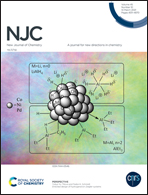A competitive effect of acceptor substitutions on the opto-electronic features of triphenylamine cored di α-cyanostilbene derivatives†
Abstract
Three novel triphenylamine cored di-branched α-cyanostilbenes with different electron-acceptors [H (neutral), CF3, and NO2] were synthesized. All the compounds exhibited a distinct positive solvatochromism dependent on the polarity and nature of the acceptor unit. Emission in binary solvent mixture reveals that CF3 substituted chromophores promote the AIE effect with moderate emission wavelength shift. In contrast, NO2 substitution drives the emission to a longer wavelength due to pronounced ICT but with quenched emission. Introducing CF3 and NO2 into a single molecule has a competing effect, i.e., balancing the pull–pull interactions enabled the enhancement of ICT characteristics with a moderate ACQ to AIE effect. These studies reveal that electron-accepting functionalities create a considerable impact on an otherwise identical template's optoelectronic characteristics. DFT and TDDFT analysis correlate the absorption and wavelength shift with acceptor functionality, and DOS-PDOS analysis helps predicting their photophysical characteristics upon photoexcitation. PES scan studies demonstrated that arms with strong acceptor units increased the energy barrier of dynamic intramolecular rotation of the α-cyano unit.



 Please wait while we load your content...
Please wait while we load your content...